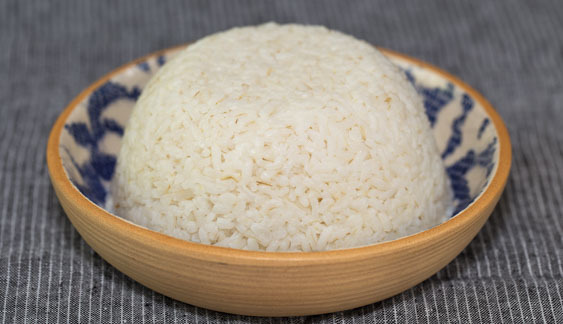Semi-Sticky, Super-Simple Laurel-Aged Charleston Gold Rice

introduction
Short-grain Japanese rice, the type used to make sushi, is generally considered “sticky” rice. The same adjective rings woefully inadequate however, when applied as a descriptor for Thai sticky rice—which, like other glutinous-rice preparations, is sticky almost beyond comprehension. It is so sticky, in fact, that the most effective utensils to use are fingers.
We appreciate that glutinous rice is the classic Asian rice for sticky rice cookery. Sticky rice delivers pleasure in three modalities: the tactile sensation you get from ripping the rice from a mound with your fingers; the fun of rolling it between your fingers; and the magical capacity of the rice you’ve just made to sponge up fiery hot sauces and push back spring-like in your mouth. Primitive, yes. Satisfying, absolutely.
To accompany our Thai beef salad—which is traditionally served alongside real sticky rice—we wanted a simple side dish with at least some of the fat, satisfying chew one experiences in the real deal. We devised a method to induce the grains of our own aromatically charged Laurel-Aged Charleston Gold Rice to cling to each other. The rice isn’t basket-steamed in the traditional way. Rather, it is slightly over-hydrated and cooked gently in a pan under tight cover so that the rice starches (medium amylase for you nerds out there) gel in such a way that the grains stick together. We might set out a traditional Southern rice spoon when we serve the dish (which true glutinous sticky rice wouldn’t be caught dead with), but our favorite way is to place a bowl in the center of the table, ask everyone to tear portions with their fingers, and dip or nibble along with the accompanying dish. Proper sticky rice it is not, but the flavor and mouthfeel of Charleston Gold and its can-do spirit make it a worthy companion to Thai Beef Salad and other Asian dishes.
Cooking Remarks
Rice served as a part of an Asian meal is not salted, but if you absolutely must, add ½ teaspoon of fine sea salt to the boiling water along with the rice.
equipment mise en place
For this recipe, you will need a heavy-bottomed medium saucepan, a wooden spoon, and, if shaping the rice in molds, four 1-cup ramekins or bowls.
-
-
1¾cups spring or filtered water
-
1cup (7 ounces) Anson Mills Laurel-Aged Charleston Gold Rice
-
Neutral oil, if molding the rice
-
Anson Mills Sea Island Benne Seeds, toasted, if molding the rice (optional)
-
-
In a heavy-bottomed medium saucepan, bring the water to a boil, covered, over medium-high heat. As soon as the water boils, stir in the rice, cover, and reduce the heat to low. Simmer very gently without lifting the lid for 15 minutes. Remove the pan from the heat allow to rest for 5 minutes.
-
At this point, you may simply fluff the rice and shuttle it into a bowl and serve it or grease four 1-cup ramekins or bowls with neutral oil, sprinkle the insides with toasted benne seeds if desired, and pack the rice into the molds. To serve, invert each portion onto a plate.